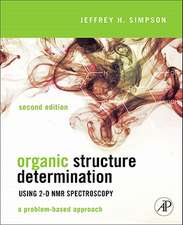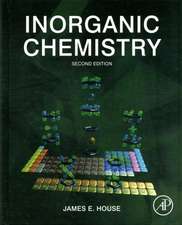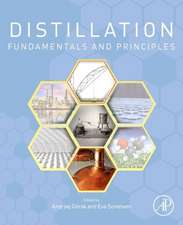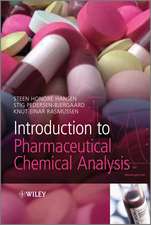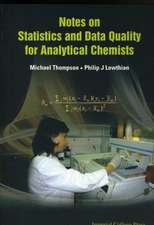Enrichment Techniques for Inorganic Trace Analysis: Anleitungen für die chemische Laboratoriumspraxis, cartea 19
Autor Atsushi Mizuikeen Limba Engleză Paperback – 10 dec 2011
Din seria Anleitungen für die chemische Laboratoriumspraxis
- 15%
 Preț: 438.07 lei
Preț: 438.07 lei -
 Preț: 347.04 lei
Preț: 347.04 lei -
 Preț: 422.90 lei
Preț: 422.90 lei -
 Preț: 413.27 lei
Preț: 413.27 lei -
 Preț: 487.37 lei
Preț: 487.37 lei -
 Preț: 422.52 lei
Preț: 422.52 lei - 15%
 Preț: 439.05 lei
Preț: 439.05 lei - 15%
 Preț: 436.28 lei
Preț: 436.28 lei - 15%
 Preț: 438.40 lei
Preț: 438.40 lei - 15%
 Preț: 451.64 lei
Preț: 451.64 lei -
 Preț: 480.83 lei
Preț: 480.83 lei - 15%
 Preț: 468.90 lei
Preț: 468.90 lei - 15%
 Preț: 472.84 lei
Preț: 472.84 lei - 15%
 Preț: 473.49 lei
Preț: 473.49 lei -
 Preț: 409.80 lei
Preț: 409.80 lei -
 Preț: 444.94 lei
Preț: 444.94 lei -
 Preț: 411.32 lei
Preț: 411.32 lei -
 Preț: 409.80 lei
Preț: 409.80 lei - 15%
 Preț: 489.95 lei
Preț: 489.95 lei -
 Preț: 416.54 lei
Preț: 416.54 lei -
 Preț: 446.47 lei
Preț: 446.47 lei -
 Preț: 424.22 lei
Preț: 424.22 lei
Preț: 381.43 lei
Nou
Puncte Express: 572
Preț estimativ în valută:
72.99€ • 78.05$ • 60.85£
72.99€ • 78.05$ • 60.85£
Carte tipărită la comandă
Livrare economică 18 aprilie-02 mai
Preluare comenzi: 021 569.72.76
Specificații
ISBN-13: 9783642688560
ISBN-10: 364268856X
Pagini: 156
Ilustrații: VIII, 144 p.
Dimensiuni: 170 x 244 x 8 mm
Greutate: 0.26 kg
Ediția:Softcover reprint of the original 1st ed. 1983
Editura: Springer Berlin, Heidelberg
Colecția Springer
Seria Anleitungen für die chemische Laboratoriumspraxis
Locul publicării:Berlin, Heidelberg, Germany
ISBN-10: 364268856X
Pagini: 156
Ilustrații: VIII, 144 p.
Dimensiuni: 170 x 244 x 8 mm
Greutate: 0.26 kg
Ediția:Softcover reprint of the original 1st ed. 1983
Editura: Springer Berlin, Heidelberg
Colecția Springer
Seria Anleitungen für die chemische Laboratoriumspraxis
Locul publicării:Berlin, Heidelberg, Germany
Public țintă
ResearchCuprins
1 Introduction.- 1.1 Inorganic Trace Analysis in Science and Technology.- 1.2 The Role of Enrichment Techniques in Inorganic Trace Analysis.- 2 General Aspects of Enrichment Techniques.- 2.1 Trace Recovery.- 2.2 Enrichment Factor.- 2.3 Contamination.- 2.4 Simplicity and Rapidity.- 2.5 Sample Size.- 3 Control of Contamination and Loss.- 3.1 Airborne Contamination.- 3.2 Contamination and Loss Due to Apparatus.- 3.3 Contamination Due to Reagents.- 3.4 Other Sources of Contamination and Loss.- 4 Volatilization.- 4.1 Volatilization from Solutions.- 4.2 Volatilization from Solid and Molten States.- 5 Liquid-Liquid Extraction.- 5.1 General Procedures.- 5.2 Extraction of Metal Chelates.- 5.3 Extraction of Ion Pairs.- 5.4 Special Extractions.- 6 Selective Dissolution.- 6.1 Selective Dissolution of the Matrix.- 6.2 Selective Dissolution of Trace Elements.- 7 Precipitation.- 7.1 Precipitation of Matrix Elements.- 7.2 Precipitation of Trace Elements.- 8 Electrochemical Deposition and Dissolution.- 8.1 Electrodeposition on Solid Electrodes.- 8.2 Electrodeposition on Mercury Cathodes.- 8.3 Spontaneous Electrochemical Deposition.- 8.4 Anodic Dissolution.- 9 Sorption, Ion Exchange and Liquid Chromatography.- 9.1 General Procedures.- 9.2 Separation with Ion Exchange Resins.- 9.3 Separation with Cellulosic Exchangers.- 9.4 Separation with Polyurethane Foams.- 9.5 Separation with Miscellaneous Organic Sorbents.- 9.6 Separation with Activated Carbon.- 9.7 Inorganic Ion Exchangers.- 10 Flotation.- 10.1 General Procedures.- 10.2 Carrier Precipitation Followed by Flotation.- 10.3 Ion Flotation.- 11 Freezing and Zone Melting.- 11.1 Freeze Concentration of Dilute Aqueous Solutions.- 11.2 Enrichment of Impurities in Solids by Zone Melting.- 12 Enrichment Techniques in Water Analysis.- 12.1 Separation Based on the Particle Size and Density.- 12.2 Separation Based on Chemical Reactivity.- 13 Enrichment Techniques in Gas Analysis.- 13.1 Separation of Particles.- 13.2 Separation of Gaseous Trace Constituents.- Literature.- A.1 Solvents.- A.2 Masking Agents.- A.3 Ion Exchange Data.- Index of Abbreviations and Symbols.

